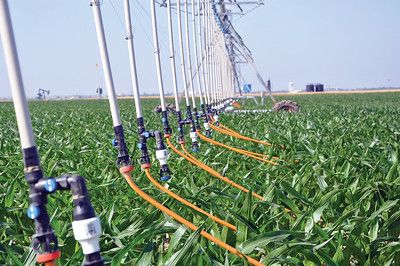7 Types of Piezoelectric Materials Explained
Types of piezoelectric materials are; single-crystals, polymers, ceramics, relaxors, relaxor-ferroelectrics, high-temperature, and lead-free piezoelectrics.
They are classified or distinguished based on chemical composition, structure, and physical characteristics.
This article discusses the types of piezoelectric materials, as follows;
1). Single Crystals (as one of the Types of Piezoelectric Materials)
As the term implies, piezoelectric single crystal materials are those which posses crystalline or regular-repeating chemical structures, and are capable of facilitating electricity generation from stress or other mechanical variables.
There are many crystals that are piezoelectric (in terms of crystal classes), and various chemical compounds may be classified as piezoelectric single crystals.
However, the degree of piezoelectric behavior varies significantly with crystal structure, and chemical composition.
Also, single crystal piezoelectric materials are one of the most common categories, and are used in various types of piezoelectric sensors, as well as biomedical transducers, actuators, and other technologies that are based on piezoelectricity [8].
Aside being common, piezoelectric single crystals are known for their excellent conversion characteristics [2] compared to other piezoelectric materials.
Examples of piezoelectric single crystals are; quartz (SiO2), lithium tetraborate (LiB4O7), lead zirconate niobate / lead titanate (PZN-PT), lead magnesium niobate / lead titanate (PMN-PT), and lithium niobate (LiNbO3).

2). Polymers
Polymers that are piezoelectric include those which are capable of generating significant clusters of electric charges on their surfaces, when placed under mechanical stress or strain.
Ferroelectric polymers are known as dominant category of piezoelectric materials, and this can be attributed to their good conduction properties [1].
Charge-buildup around molecular dipoles in the chemical structural-chain of polymeric materials is largely responsible for their piezoelectric behavior.
The advantages of this type of piezoelectric material include; mechanical resilience, flexibility and relatively-low environmental impact.
Examples of piezoelectric polymers are; poly(vinylidene fluoride) (PVDF) and poly(vinylidene fluoride-co-trifluoroethylene) (PVDF-TrFE) [7]. Polymer composites are a subcategory of piezoelectric materials that are made from polymers like poly(dimethyl siloxane) (PDMS), ans ceramic nano particles. They also exhibit piezoelectric properties.
3). Ceramics (as one of the Types of Piezoelectric Materials)
Piezoelectric ceramic materials are polycrystalline, ferroelectric, earthen materials that are capable of converting mechanical stress or strain to electric charges.
Piezoelectric ceramics are made through controlled thermal treatment of the crushed form of piezoelectric metallic oxides like lead zirconate titanate (PZT).
The metals in their chemical structure account for their ferroelectric behavior, which makes them applicable in the production of piezoelectric sensors, among other similar devices.
Ceramic piezoelectric sensors are simple detection devices for measurement of mechanical variables, which are equipped with any of the available piezoelectric ceramic materials as their primary sensory component.
The piezoelectric behavior of ceramics is dependent on environmental factors like temperature [4].
Lastly, piezoelectric ceramic materials are multifunctional in nature, and can exhibit a broad range of behaviors under various circumstances.
Aside PZT, other metallic oxides like barium titanate can also be described as piezoelectric ceramics.
4). Relaxors
Relaxors are a group of piezoelectric materials with high permittivity, anomalous behavior, and the ability to form solid solution with ferroelectric materials [6].
The piezoelectric attributes of relaxor materials are mostly exhibited under a DC field.
Also, their piezoelectric response is increased significantly by the solid-solution characteristics of these materials.
Lead zirconate titanate (PZT) is an example of a relaxor piezoelectric material.
5). Relaxor-ferroelectrics (as one of the Types of Piezoelectric Materials)
Relaxor-ferroelectrics are a type of piezoelectric material that comprises of a solid solution of relaxors and normal ferroelectric compounds.
A unique property of relaxor-ferroelectrics is their performance, which is characterized by ultrahigh piezoelectricity and electrorestriction, as well as dielectric properties [3].
The characteristics of relaxor-ferroelectrics may vary widely with changes in temperature, among other environmental conditions.
While their piezoelectric behavior is similar to that of single crystals, they have much higher permittivity and thus piezoelectricity.
An example of relaxor-ferroelectric materials is a solid solution of PMN-PbTiO3 and PZN-PbTiO3.
6). High-temperature Piezoelectrics
High temperature piezoelectric materials are chemical compounds that are capable of exhibiting significant piezoelectric behavior under high temperature conditions.
The need for this type of piezoelectric material arises from practical applications where mechanical variable-detection is to be carried out in high-temperature systems like turbines, automobile and aircraft engines, nuclear reactors, among others.
For such applications, having piezoelectric materials that can withstand high temperature while still exhibiting piezoelectric characteristics, is essential.
In addition to being able to operate under high temperature, the high-temperature piezoelectric materials are able to function effectively under conditions of high resonance or vibration frequency.
In view of their importance, the development of high-temperature piezoelectric materials has been faced with many challenges including cost, and consistency of piezoelectric behavior.
While most of these materials are manmade; considerations of naturally-occurring materials that can be slightly modified for this purpose include quartz and tourmaline.
7). Lead-free Piezoelectrics (as one of the Types of Piezoelectric Materials)
Lead-free piezoelectric materials, as the name implies; are piezoelectric materials whose chemical composition does not include lead.
The importance of this type of piezoelectric materials stems from the need to achieve sustainability in the energy and technological sectors, by mitigating the role of energy conversion and technology, in environmental degradation.
Removal of lead which is a major contributor to environmental pollution, from the piezoelectric scene, will increase the relevance and application of piezoelectricity in the agenda for energy transition.
Most lead-free piezoelectric materials are ceramics, and are produced through deliberate evaluation and selection of suitable materials.
Examples of lead-free piezoelectric materials are; sodium potassium niobate ((K,Na)NbO3; KNN) based-, barium titanate (BaTiO3; BT) based-, bismuth layer-structured ferroelectrics, and sodium bismuth titanate ((Bi1/2Na1/2)TiO3; BNT) based-ceramic materials [5].
Some of these materials have exhibited excellent piezoelectric or electromechanical conversion capabilities.
Conclusion
Types of piezoelectric materials are;
1. Single Crystals
2. Polymers
3. Ceramics
4. Relaxors
5. Relaxor-ferroelectrics
6. High-temperature Piezoelectrics
7. Lead-free Piezoelectrics
References
1). Bauer, F.; Heywang, W.; Lubitz, K.; Wersing, W. (2008). “Piezoelectric Polymers and Their Applications.” Piezoelectricity (pp.157-177). Available at: https://doi.org/10.1007/978-3-540-68683-5_6. (Accessed 5 December 2022).
2). Dhar, R. (2009). “Growth and optimization of piezoelectric single crystal transducers for energy harvesting from acoustic sources.” Available at: https://www.researchgate.net/publication/252292717_Growth_and_optimization_of_piezoelectric_single_crystal_transducers_for_energy_harvesting_from_acoustic_sources.(Accessed 6 December 2022).
3). Li, F.; Zhang, S.; Yang, T.; Xu, Z.; Zhang, N.; Liu, G.; Wang, J.; Cheng, Z. X.; Ye, Z.; Luo, J.; Shrout, T. R.; Chen, L. (2016). “The origin of ultrahigh piezoelectricity in relaxor-ferroelectric solid solution crystals.” Nature Communications 7(1). Available at: https://doi.org/10.1038//ncomms13807. (Accessed 6 December 2022).
4). Miclea, C.; Tanasoiu, C.; Amarande, L.; Miclea, C. F.; Plavitu, C.; Cioangher, M.; Trupina, L.; Miclea, C.; David, C. (2007). “Effect of temperature on the main piezoelectric parameters of a soft PZT ceramic.” Romanian Journal of Information Science and Technology 10(3):243-250. (Accessed 6 December 2022).
5). Noorhashimah, M. N.; Hamzah, H. H.; Razak, K. A. (2021). “Recent advancement in sustainable energy harvesting using piezoelectric materials.” Sustainable Materials for Next Generation Energy Devices (pp.221-248). Available at: https://doi.org/10.1016/B978-0-12-820628-7.00009-5. (Accessed 5 December 2022).
6). Yasuda, N.; Fuwa, T.; Ohwa, H.; Tachi, Y.; Yamashita, Y. (2011). “The effect of poling and depoling on the dielectric and piezoelectric properties of relaxor ferroelectric solid solution single crystal of 24Pb(In1/2Nb1/2)O3 -46Pb(Mg1/3Nb2/3)O3 -30PbTiO3.” Applications of Ferroelectrics (ISAF/PFM), 2011 International Symposium on and 2011 International Symposium on Piezoresponse Force Microscopy and Nanoscale Phenomena in Polar Materials. Available at: https://doi.org/10.1109/ISAF.2011.6013980. (Accessed 6 December 2022).
7). Zhao, C.; Hong, Y.; Chu, X.; Dong, Y.; Hu, Z.; Sun, X.; Yan, S. (2021). “Enhanced Ferroelectric Properties of P(VDF-TrFE) Thin Film on Single Layer Graphene Simply Adjusted by Crystallization Condition.” Materials Today Energy 20:100678. Available at: https://doi.org/10.1016/j.mtener.2021.100678. (Accessed 6 December 2022).
8). Zhou, Q.; Lam, K. H.; Zheng, H.; Qui, W.; Shung, K. K. (2014). “Piezoelectric single crystal ultrasonic transducers for biomedical applications.” Progress in Materials Science 66. Available at: https://doi.org/10.1016/j.pmatsci.2014.06.001. (Accessed 5 December 2022).




